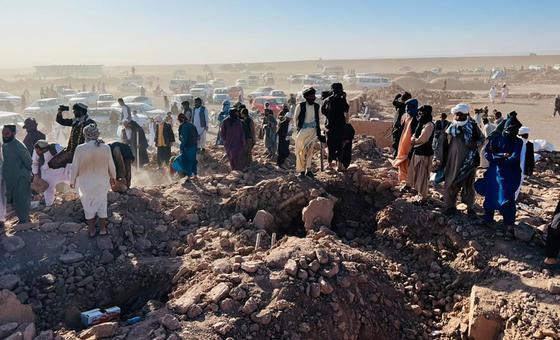Nearly 500 people are still missing from the worst-affected area of a 6.3 magnitude earthquake that rocked Herat province in western Afghanistan on Saturday, UN aid coordinators said on Tuesday.
At the epicentre of the earthquake in Zindajan district, the UN aid coordination office (OCHA) recorded nearly 1,300 deaths and 1,700 injuries. In some places, entire villages have been destroyed, according to teams on the ground.
Over 12,000 affected
An estimated 12,110 people, or 1,730 families, have been affected in five districts of Herat. That number is expected to rise as assessments continue, said OCHA spokesperson, Jens Laerke, speaking in Geneva.
A series of aftershocks, including one measuring 5.1 magnitude on Tuesday, has made the situation worse. UN refugee agency, UNHCR, spokesperson William Spindler said that amid extensive damage and traumatized survivors, search-and-rescue teams are on the way with water and shelter for the most vulnerable.
Those worst-hit have lost all their belongings and as winter approaches they need warm clothing, Mr. Spindler explained, before adding that many “have not had a warm meal since the earthquake”.

UNICEF staff assess the earthquake damage in Karinal village, Herat province in Afghanistan.
Health services
World Health Organization (WHO) spokesperson Tarik Jasarevic said that the immediate focus now is to save the lives of the injured and to ensure survivors have access to humanitarian relief, including essential health services. “Women, children and vulnerable populations are gravely affected by the disaster,” he said, adding that female health workers in the country continue to attend to patients, with no discrimination.
Mr. Jasarevic confirmed that the UN health agency has provided enough supplies to treat 650 injured patients at Herat Regional Hospital. An additional 25 metric tonnes of medicines and medical supplies have also been sent to Herat, while 54 mobile health teams, including three by WHO, have been deployed in the affected areas and 12 ambulances have been sent to Zindajan District and Ghorian District to evacuate causalities to the regional and other hospitals.
Risk of disease
The WHO spokesperson warned that displacement caused by the disaster poses a significant health risk, including increasing the transmission of infectious diseases, such as measles, acute respiratory infections and acute watery diarrhoea. He urged the authorities to boost preparedness in the event of disease outbreaks.
He also called for psychological first aid for the survivors and friendly spaces for the children who have experienced significant stress and loss of loved ones. Echoing those concerns OCHA’s Mr. Laerke warned that children are particularly vulnerable, having suffered severe psychological distress from the earthquake, and require mental health and psychosocial support.
Humanitarian relief
Mr. Laerke said that search-and-rescue efforts with the support of international partners were ongoing. According to WHO, as of Sunday 8 October, more than 550 severe and critical cases have been admitted to seven hospitals in Herat City.
Emergency shelters, as well as longer-term solutions to withstand winter, non-food items, such as tarps, blankets, clothes, and kitchen sets and WASH items, such as latrines, potable water and storage containers, as well as food assistance and protection, are also being provided as a priority.

